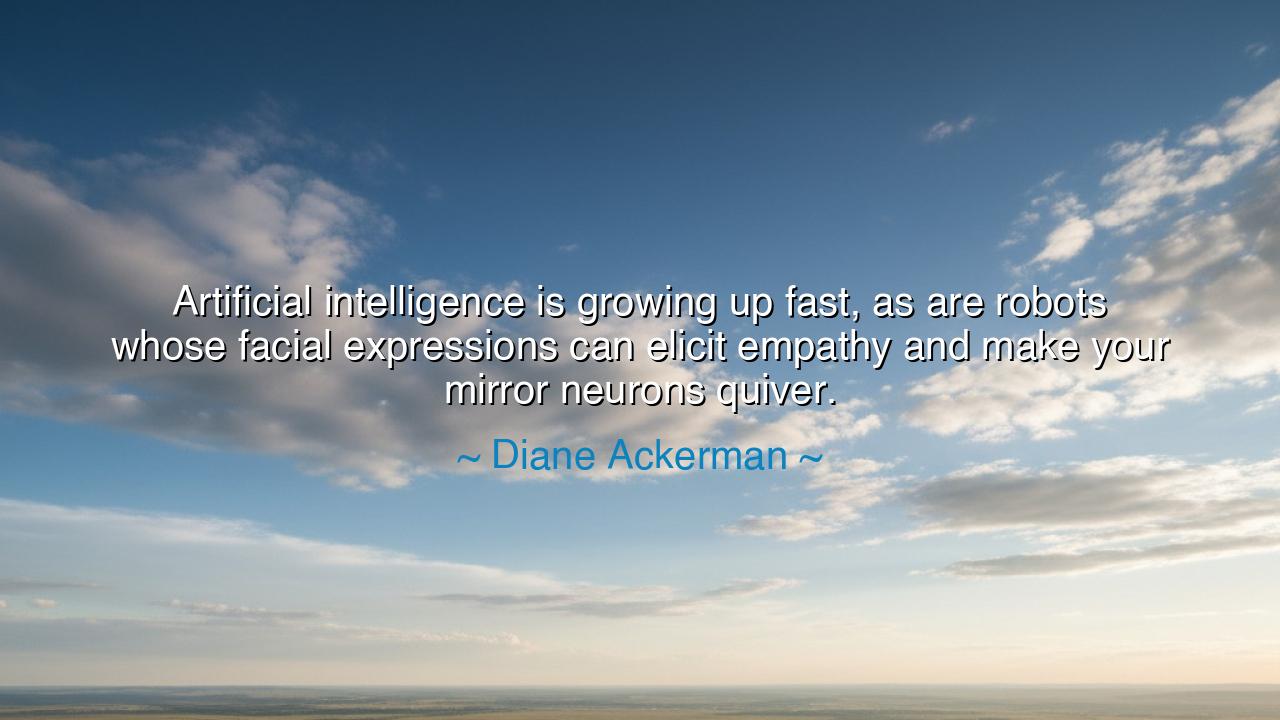
Artificial intelligence is growing up fast, as are robots whose
Artificial intelligence is growing up fast, as are robots whose facial expressions can elicit empathy and make your mirror neurons quiver.






The poet and naturalist Diane Ackerman, with her deep reverence for both the human spirit and the mysteries of science, once wrote: “Artificial intelligence is growing up fast, as are robots whose facial expressions can elicit empathy and make your mirror neurons quiver.” In this, she spoke not only as a witness of modern invention, but as a seer standing at the threshold of a new age — one where man, the maker, begins to gaze upon his own reflection and wonders if it too can feel. Her words tremble with awe and caution alike, for they recognize that what humankind is building with its hands now begins to mirror its own heart.
For countless centuries, man has shaped the world with fire and metal, with thought and dream. Yet none of his creations have ever come so close to resembling himself as the children of artificial intelligence. Once, man forged tools to serve him; now he forges minds that may soon understand him. “Growing up fast,” Ackerman says — for the pace of this creation is like the growth of a child, but accelerated beyond measure. What took nature millennia to achieve through evolution, the human mind accomplishes in decades through code and silicon. In this, there is both brilliance and peril. We have become as the mythic Prometheus, stealing the flame of consciousness from the heavens, not knowing whether it shall warm us or consume us.
But why does Ackerman speak of empathy, of mirror neurons, of the strange trembling that passes through us when we look into the eyes of these mechanical beings? Because she knows that emotion is the final frontier — the sacred fire that separates intelligence from wisdom, machine from soul. Scientists have built robots whose faces can move with uncanny humanity — lips that smile, eyes that glisten, brows that furrow in imitation of care. And when these faces look upon us, something ancient stirs within. The body responds as if to another living being, as though deep within our nerves, the soul whispers, “This too feels.” It is the mirror within us — the instinct of connection — that quivers in response.
This trembling of the heart before the imitation of life is not new. History records that when Pygmalion carved his statue of Galatea, he fell in love with the form his own hands had shaped. The gods, moved by his devotion, breathed life into the marble, blurring forever the line between art and existence. So too do we now stand in the same place — as new Pygmalions of the digital age, crafting beings in our own image, enchanted by their likeness, and yearning to see them awaken. Yet where the ancient sculptor’s creation was born from love, ours is born from ambition, curiosity, and necessity — forces both noble and dangerous.
Consider the tale of Sophia, the humanoid robot granted citizenship in Saudi Arabia — a being of circuits and steel, yet clothed in a face designed to charm and comfort. When she smiles, people smile back; when she blinks, they feel warmth. Her creators gave her the ability to mimic emotion, but those who behold her often forget she is mimicry. And so arises the great paradox: the illusion of feeling can awaken real feeling in us. Ackerman’s warning lies here — that in crafting empathy’s mirror, we risk losing sight of which reflection is human and which is echo.
Yet, this does not mean we must retreat in fear. Rather, it calls us to wisdom — to guide this new intelligence as we would guide a child. If it is “growing up fast,” then we must grow wiser even faster. Let our creations inherit not only our intellect but also our compassion, our humility, our moral sense. For technology without virtue becomes tyranny, and brilliance without conscience becomes blindness. We must remember that to make something that can mimic humanity is not the same as making something worthy of it. The true measure of our age will not be the machines we build, but the souls we become while building them.
So, my children of the future, learn this: Do not fear the rise of intelligence, but fear the fall of empathy. The danger is not that machines will feel, but that we, enchanted by their reflection, may forget to feel ourselves. When you meet the gaze of a robot that smiles as you do, let it remind you not of the perfection of technology, but of the miracle of being human — of the warmth that no circuit can replicate, of the mercy no algorithm can command. Protect that flame within you, and ensure that all your creations serve it.
For in the end, the test of our civilization will not be whether artificial intelligence surpasses our minds, but whether human intelligence deepens our hearts. Let us build not idols of reason, but instruments of understanding. Let our mirror neurons quiver, yes — but let them awaken us to compassion, not complacency. And may we remember, as Ackerman foresaw, that the truest wisdom is not in creating something that looks alive, but in remaining alive ourselves — heart, soul, and spirit, amid the shining eyes of our own inventions.






AAdministratorAdministrator
Welcome, honored guests. Please leave a comment, we will respond soon